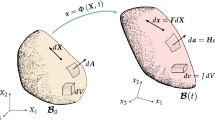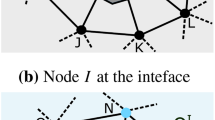Abstract
A new 2D quadrilateral element is developed for the modelling of 2D incompressible rigid/viscoplastic problems: the QMITC-3F. The element formulation is based on the interpolation of three fields: velocities, strain rates and pressures. The incompressibility constraint is enforced using an Augmented Lagrangian technique. The new element is used in conjunction with the flow formulation and the pseudo-concentrations technique for modelling bulk metal forming processes.
Similar content being viewed by others
References
Argyris, J. H.; Doltsinis, J. St.; Knudson, W. C.; Szimmot, J.; Willam, K. J.; Wüstenberg, H. 1980: Eulerian and Lagrangian techniques for elastic and inelastic large deformation processes. In: J. T.Oden (Ed.), Computational Methods in Nonlinear Mechanics, 13–66, North-Holland, Amsterdam
Backofen, W. A. 1972: Deformation Processing, Addison-Wesley, Reading, MA
Bathe, K. J. 1982: Finite Element Procedures in Engineering Analysis. Prentice-Hall, Englewood Cliffs, NJ
Brooks, A. N.; Hughes, T. J. R. 1982: Streamline upwind/Petrov-Galerkin formulations for convection dominated flows with particular emphasis on the incompressible Navier-Stokes equations. Comp. Meth. Appl. Mech. Engrg. 32: 199–259
Chen, C. C.; Kobayashi, S. 1979: Rigid-plastic finite element analysis of plastic deformation in metal-forming processes. Technical Report AFML-TR-79-4105, USA Wright-Patterson Air Force Base
Codina, R. 1993a: An iterative penalty method for the finite element solution of the stationary Navier-Stokes equations. Comp. Meth. Appl. Mech. Engrg. 110: 237–262
Codina, R. 1993b. A discontinuity-capturing crosswind-dissipation for the finite element solution of the convection-diffusion equation. Comp. Meth. Appl. Mech. Engrg. 110: 325–342
Dvorkin, E. N.; Assanelli, A. P. 1990: Elasto-plastic analysis using a quadrilateral 2D element based on mixed interpolation of tensorial components. In: Owen, D. R. J. et al. (Eds.), Proc. Second International Conference on Computational Plasticity, 263–283, Pineridge Press, Swansea
Dvorkin, E. N.; Canga, M. E. 1993: Incompressible viscoplastic flow analysis using a quadrilateral 2D element based on mixed interpolation of tensorial components. Commun. Num. Meth. Eng. 9: 157–164
Dvorkin, E. N.; Pantuso, D.; Repetto, E. A. 1994: A finite element formulation for finite strain elasto-plastic analysis based on mixed interpolation of tensorial components. Comp. Meth. Appl. Mech. Engrg. 114: 35–54
Dvorkin, E. N.; Petöcz, E. G. 1992: On the modelling of 2D metal forming processes using the flow formulation and the pseudo-concentrations technique. In: Owen, D. R. J. et al. (Eds.), Proc. Third Int. Conf. on Computational Plasticity, 1037–1052, Pineridge Press, Swansea
Dvorkin, E. N.: Petöcz, E. G. 1993: An effective technique for modelling 2D metal forming processes using an Eulerian formulation. Eng. Comput. 10: 323–336
Dvorkin, E. N.; Vassolo, S. I. 1989: A quadrilateral 2D finite element based on mixed interpolation of tensorial components. Eng. Comput 6: 217–224
Felippa, C. A. 1978: Iterative procedures for improving penalty function solutions of algebraic systems. Int. J. Num. Meth. Engrg., 12: 821–836
Fortin, M.; Fortin, A. 1985: A generalization of Uzawa's algorithm for the solution of the Navier-Stokes equations. Commun. Num. Meth. Eng. 1: 205–208
Hughes, T. J. R.; Brooks, A. 1982: A theorical framework for Petrov-Galerkin methods with discontinuous weighting functions: application to the streamline-upwind procedure. In: Gallagher, R. H. et al. (Eds.), Finite Elements in Fluids, Vol. 4, 47–65, John Wiley & Sons Ltd, New York
Kobayashi, S.; Oh, S.; Altan, T. 1989: Metal forming and the finite-element method, Oxford University Press, New York
Li, G.; Kobayashi, S. 1982: Rigid-plastic finite-element analysis of plane strain rolling. J. of Engineering for Industry., 104: 55–63
Luenberger, D. G. 1984: Linear and Nonlinear Programming, Addison-Wesley, Reading, MA
Malvern, L. E. 1969: Introduction to the Mechanics of a Continuous Medium, Prentice-Hall, Englewood Cliffs, New Jersey
Perzyna, P. 1966: Fundamental problems in viscoplasticity. Advances in Applied Mechanics., 9, Academic Press, New York
Simo, J. C.; Laursen, T. A. 1992: An Augmented Lagrangian treatment of contact problems involving friction. Comp. & Struct. 42: 97–116
Thompson, E. 1986: Use of the pseudo-concentrations to follow creeping viscous flows during transient analysis. Int. J. Num. Meth. Fluids 6: 749–761
Thompson, E.; Smelser, R. E. 1988: Transient analysis of forging operations by the pseudo-concentrations method. Int. J. Num. Meth. Engrg. 25: 177–189
Washizu, K. 1982: Variational Methods in Elasticity & Plasticity, Pergamon Press, Oxford
Zienkiewicz, O. C.; Jain, P. C.; Oñate, E. 1977: Flow of solids during forming and extrusion: some aspects of numerical solutions. Int. J. Solid Struct. 14: 15–28
Zienkiewicz, O. C.; Taylor, R. L. 1989: The Finite Element Method, 4th Edn., McGraw-Hill, New York
Zienkiewicz, O. C., Vilotte, J. P.; Toyoshima, S.; Nakazawa, S. 1985: Iterative method for constrained and mixed approximation. An inexpensive improvement of FEM performance. Comp. Meth. Appl. Mech. Engrg. 51: 3–29
Author information
Authors and Affiliations
Additional information
Communicated by S. N. Atluri, 18 August 1995
Dedicated to J. C. Simo
Rights and permissions
About this article
Cite this article
Dvorkin, E.N., Cavaliere, M.A. & Goldschmit, M.B. A three field element via Augmented Lagrangian for modelling bulk metal forming processes. Computational Mechanics 17, 1–9 (1995). https://doi.org/10.1007/BF00356474
Issue Date:
DOI: https://doi.org/10.1007/BF00356474




